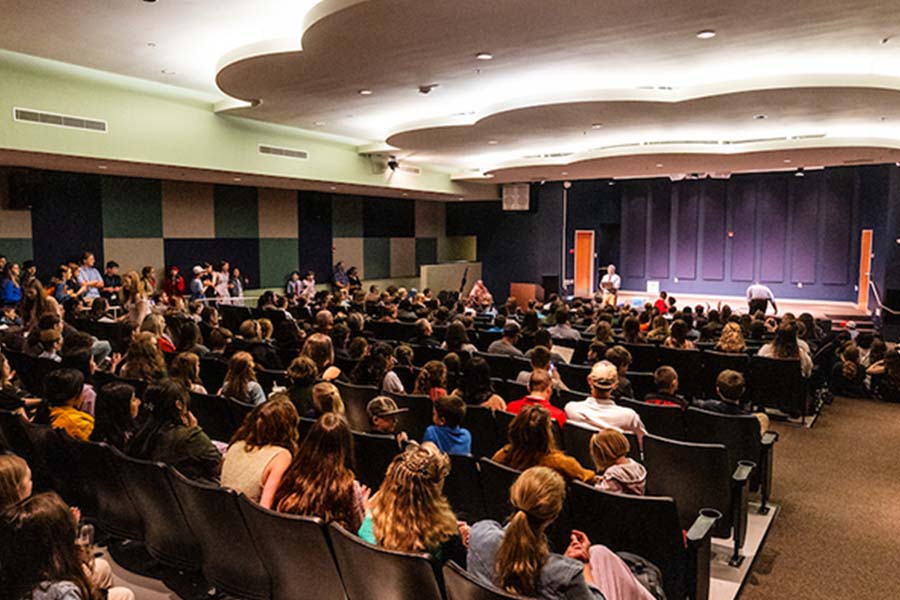Virginia History Day contest draws more than 200 young competitors to campus
by Neil Harvey
March 25, 2024

By its very nature, the Virginia History Day competition focuses on the past, but
in the New River Valley, its present and future seem to be gaining traction as well.
On March 15, as it has done since 1996, Radford University hosted Virginia History Day’s District 3 contest, and students from a dozen local schools came to present their research projects and have them evaluated by judges.
In reviewing the entry list, one of the event’s organizers noticed an encouraging
trend.
“Three years ago, the number of students attending was in the 50s,” said Ann Roberts
of the School of Teacher Education and Leadership (STEL), which oversees the event
for the College of Education and Human Development.
“Last year, it was 153 students,” Roberts said. “This year, it’s over 200.”
Indeed, even prior to 2020 – when the District 3 competition had to be held completely
virtually – attendance generally averaged between 50 and 70 contestants, so this current
spike represents historical growth, so much so that at the event’s awards ceremony
in the Bonnie Auditorium of the Hurlburt Student Center, university officials said
adjustments would need to be made going forward.
“I have got to say that it looks like next year we will not be in this room because
we will be in a bigger room,” STEL Director Amanda Bozack told a capacity crowd, sparking
applause.
The competitors spanned grades five through 12 and presented projects across numerous
formats – exhibits, performances, documentaries, papers and websites – with each addressing
this year’s theme: historic turning points.
Just as impressive as the spike in attendance, perhaps, was the sheer range of subjects and interests the young students chose to tackle – the attack on Pearl Harbor, Jane Goodall, the Italian Renaissance, Kristallnacht, the U.S.S. Monitor, the women’s suffrage movement, the Loving v. Virginia court case, the Voting Rights Act of 1965, Hurricane Katrina, the Treaty of Versailles and Martha Graham were just some of the dozens and dozens of research topics.
A full list of those recognized for their achievements this year is available here.
Participants who took third through first place will now advance to compete at the
state level April 27-28 at the Virginia Museum of History and Culture in Richmond,
Virginia. The national phase of the competition will be held June 9-13 at the University
of Maryland in College Park, Maryland.
Within District 3, one dozen local institutions were represented, including Blacksburg
and Pulaski middle schools; Check, Critzer, Floyd, Indian Valley, Snowville and Willis
elementary schools; Cave Spring High School; Blacksburg New School; North Cross School
and St. John Neumann Academy.
During the awards ceremony, Virginia History Day Coordinator Sam Florer thanked the
faculty organizers – including Moore, Bozack, Associate Professor of Social Studies
and Special Education Darren Minarik, and more than 40 judges – as well as the students
who spent weeks or even months preparing.
“It’s a lot of work to do this, so no matter if you win or if you lose, you should
be really proud of creating a project and being here and sharing your love of history,”
Florer told the crowd.
“Hopefully, you’ll want to keep coming back and doing this year after year.”
Afterward, Florer, who has been the Virginia History Day coordinator since 2019, said
he noticed another promising thread in 2024.
“A lot of the participants’ teachers are former students at Radford,” he said. “They
went through the teacher licensure program at Radford, and so many of them were exposed
to this program as students. Many were taught by Ann Roberts … and so that has been
a great pipeline for getting folks interested.
“Radford also always encourages their current pre-licensure students who are currently
in that program to judge at the local contest, so I would say there were probably
10 to 15 of those Radford students who served as judges,” Florer continued.
“That’s another great strategy for getting future teachers interested in wanting to get their students involved, once they have a classroom of their own.”